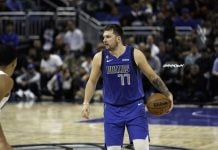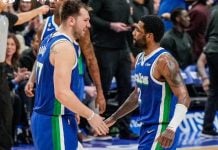When Luka Dončić entered the 2018 NBA draft, he was arguably the most accomplished prospect ever to do so. Despite his accomplishments and proven track record against elite EuroLeague competition, there were plenty of doubters. Many scouts and analysts considered him worthy of a number one overall pick, yet equally many were questioning every single aspect of his game.
From his lack of athleticism to questions on how his shooting or passing would translate to the NBA, skepticism was everywhere. After all, Luka was a European player, and no one wanted to draft another Andrea Bargnani or Darko Miličić. The fear of the relative unknown associated with European prospects is something that still leaves NBA GMs thinking twice.
However, Luka’s legendary rookie season silenced the critics and will no doubt make things easier for future European talent.
And Luka isn’t the only player helping to change perceptions within the NBA today. Jokić and Antetokounmpo are legitimate MVP candidates. Porzingis was an All-Star prior to his injury, Gobert is a defensive juggernaut, and Dončić redefined what a rookie is capable of.
Just like how these players are opening more doors to the NBA for many young European players, someone had to open the doors for them. We’re going to reflect on the players who smashed the stereotypes and paved the way for the Europeans we see in the NBA today.
Šarūnas Marčiulionis – Lithuania
Before the NBA, Marčiulionis was one of several Lithuanians on the USSR national team. In 1985 he scored 40 points in a game where he was guarded by Donnie Nelson, son of former Golden State Warriors head coach Don Nelson. The two players became friends despite the language barrier. When Donnie later became a scout, he urged his father to bring the talented guard to the NBA.
The Atlanta Hawks were also eyeing Marčiulionis, and while the Warriors drafted him in 1987, the Hawks owner Ted Turned managed to void the pick by proving Marčiulionis (23 at the time) was a year older than the age limit for international players in the draft. Turner had connections in the Soviet government as well, and he did all he could to bring Marčiulionis to Atlanta. A contract was signed in 1988 after the Soviets won gold in the Seoul Olympics, but the Hawks failed to file the paperwork with the league office on time, and Soviets wouldn’t let him leave.
Donnie hadn’t given up, and he paid numerous visits to Marčiulionis to figure out how they could bring him to the NBA. It became evident that a large percentage of Marčiulionis’ NBA salary would have to be given to the Soviet sports ministry if there was to be even a chance of letting him play. However, he knew the USSR was slowly falling apart and decided to simply sign his own deal with the Warriors in 1989 without asking any permissions. The night before, Chess player Garry Kasparov told him that tomorrow he’s either going to be the richest man in the USSR or in a work camp in Siberia.
Fortunately, he read the situation right and managed to escape the USSR without incident. His impact on the NBA was immediate. In the words of Chris Mullin, Marčiulionis shattered the stereotype of Europeans being strictly spot-up shooters and role-players by playing as a pure scorer and having a special flair of creativity in his game that rivaled that of his American peers. His aggressiveness, size, physical strength, and scoring prowess redefined what a European guard could do. He finished his playing career in 1997, and he was inducted into the Naismith Memorial Hall of Fame in 2014, as well as the FIBA Hall of Fame in 2015. Today he lives in his native Lithuania where he is a successful businessman.
Arvydas Sabonis – Lithuania
Considered one of the greatest European players of all time, Sabonis showed the world what he’s capable of while playing with Marčiulionis on the USSR national team. He was drafted by the Hawks in 1985, but the pick was voided because he was too young and he would be drafted again in 1986 by Portland. He knew nothing would come of it because the Soviets would never let him play in the US. He suffered a torn Achilles’ before the draft and was allowed to go to Portland for medical treatment and rehabilitation, but he was rushed back from the injury by the Soviets. This caused a slew of further injuries that would certainly ruin anyone else’s career.
While in Portland, Sabonis practiced with the team and made an immediate strong impression on his teammates. Many times they would cut through the paint and be hit in the head with a pass they weren’t expecting from Sabonis. It took time for them to get used to Sabonis’ incredible passing, and they couldn’t believe how a 7’3’’ giant had such a touch not just for passing, but shooting as well. Sabonis could pass, shoot threes, bang in the post and dominate down low; he could do everything except come over and play for Portland.
In 1995, an almost 31-year-old Sabonis finally came to the NBA. Portland even based some of its offense around Sabonis’ passing from the high post, but Sabonis was no longer the player he used to be. He came to Portland with such a history of injuries that Portland’s medical staff was baffled by the x-ray of his knees. They said he could qualify for a handicapped parking spot just based on that one x-ray. Yet despite his injuries and age, Sabonis was a great contributor while he was on the floor. His teammates consider him one of the biggest what-ifs in history. According to Clyde Drexler, Sabonis was so good that had he been able to play for Portland in his prime, they would have won five or six titles. His basketball IQ and incredible feel for passing and shooting showed that Europe had centers that could match up with anyone from the US. He retired from the NBA in 2003. His career was honored by his inclusion in both Naismith Memorial and FIBA Hall of Fame in 2011 and 2010 respectively.
Dražen Petrović – Croatia
Dražen was obsessed with two things in life – basketball and winning. Since his earliest childhood, he possessed a work ethic and love for the game that no one else in Europe could possibly rival. Every morning before school, he would wake up early and take at least 1000 shots before heading to school. His coaches knew that he would become a star, and they were right. When he turned pro, it was instantly clear that no defender could guard him, and he had a level of confidence unlike any of his rivals. Once he conquered Europe, his appetite turned to the NBA.
He was drafted by Portland in 1986, the same year as Sabonis, and he came over in 1989. Minutes were difficult to come by as Clyde Drexler was the team’s starting shooting guard, and Dražen was expected to be a spot-up shooter when he played. Petrović wasn’t after money in the NBA, he was motivated by competition and wouldn’t settle for garbage-time minutes. This lit a fire under him to improve both his game and his conditioning, but Portland’s coaching staff simply wasn’t giving him the chance he deserved. He wanted a trade, and in 1991 he would be traded to the New Jersey Nets, where his talents were recognized and he would quickly show the NBA what he’s capable of.
He was promised a starting spot in his next season, so he spent the summer of 1991 practically locked in a gym with the Nets’ conditioning coach Rich Dalatri. Next season he forged a reputation as a supremely skilled guard and a fierce competitor that even Michael Jordan hated playing against. In 1993 he became the first European player to ever be named to an All-NBA team. He was finally recognized as one of the best guards in the NBA and won the respect of opposing players and coaches.
His refusal to accept a reduced role that most European players were happy with, combined with his relentless work ethic and competitiveness propelled him to the status of the first true European NBA star. His life was tragically cut short in 1993 when he was killed in a traffic accident while returning home from Germany. In 2002 he was inducted into the Naismith Memorial Hall of Fame and is today remembered as one of the greatest European players of all time.
Dirk Nowitzki – Germany
Drafted in 1989, Dirk recently finished his 21-year career as a champion, an MVP, and sixth leading scorer in NBA history. Just like many foreign rookies, Dirk had a hard time adjusting to the NBA and his rookie season was mentally challenging as a result. He was very close to returning to Europe but was convinced to stay by his long-time personal trainer and mentor Holger Geschwindner. His sophomore season was a major improvement and he was slowly starting to live up to the expectations his team had.
In 2001 Dirk became the second European to be named to an All-NBA team after Dražen Petrović. In 2006 he became the first European to lead his team to the NBA finals, where they lost to Miami Heat. The following year, he became the first European to win the MVP award, and finally, in 2011 he led his team to a championship and became the first European to win the Finals MVP award. Simply put, Dirk was a phenomenon who revolutionized the league.
Many foreign NBA players owe their high draft selections to him in a way, because teams were scrambling to find “the next Dirk” after seeing the kind of impact he had on the Mavericks. While the previous players on this list all opened the league’s eyes to what European players could do, it was Dirk Nowitzki who truly sold the league on a prospect of a European franchise player. He retired after 21 seasons as one of the best power forwards and most impactful players in NBA history.
Not Just The Players
While a lion’s share of the credit for establishing European players in the NBA goes to the players on this list and their contemporaries, one must mention the role of visionary team owners and executives who gave the players a chance to prove their worth. Without people like Don and Donnie Nelson, Mark Cuban, Bucky Buckwalter, and Willis Reed, the NBA might be vastly different from what it is today. Their vision, combined with the skill and determination of elite players have ushered in a new age of the NBA as a truly global league.
Be sure to check out Max’s blog HoopsBeast and follow him on Twitter @hoops_beast!















